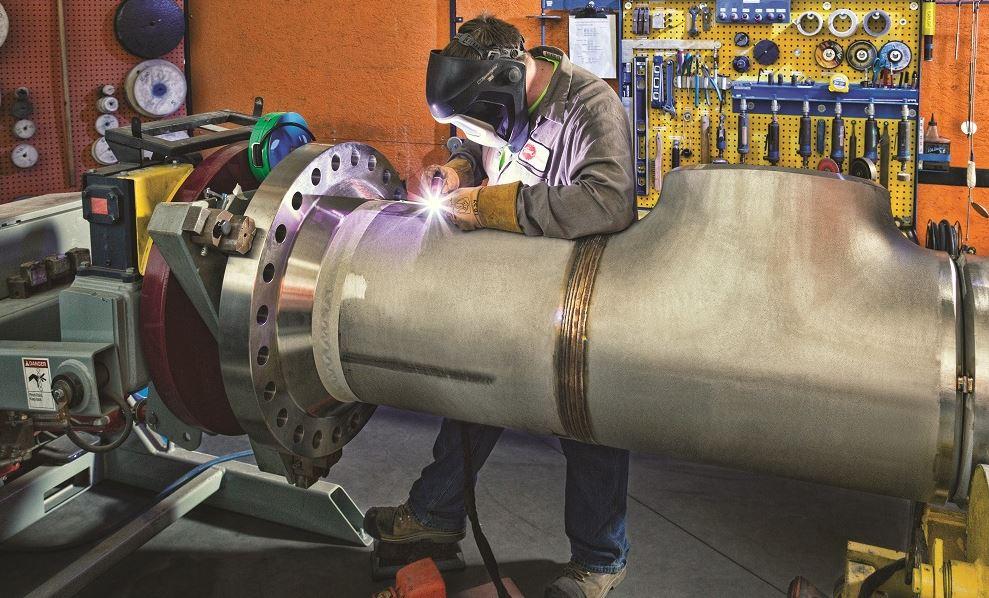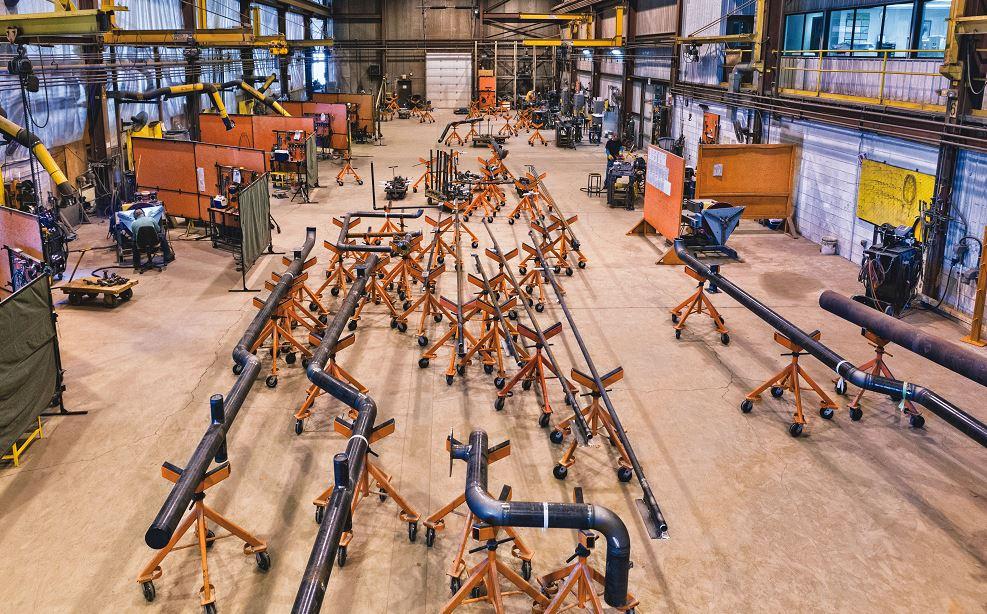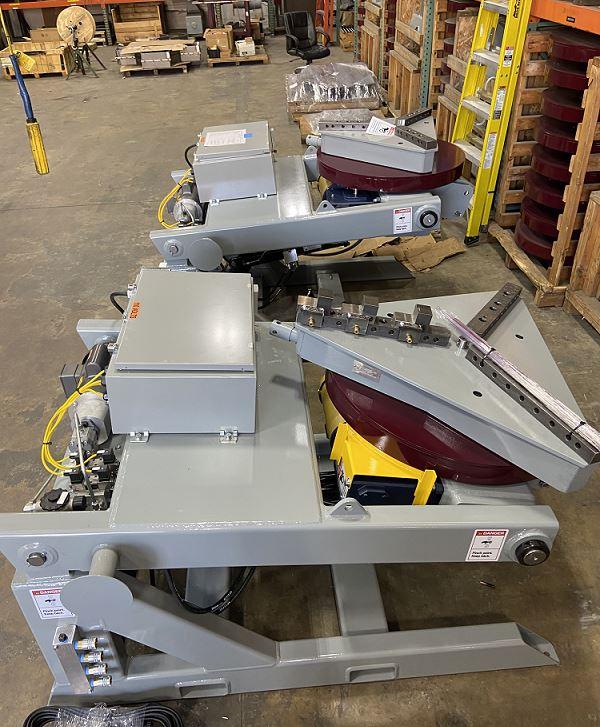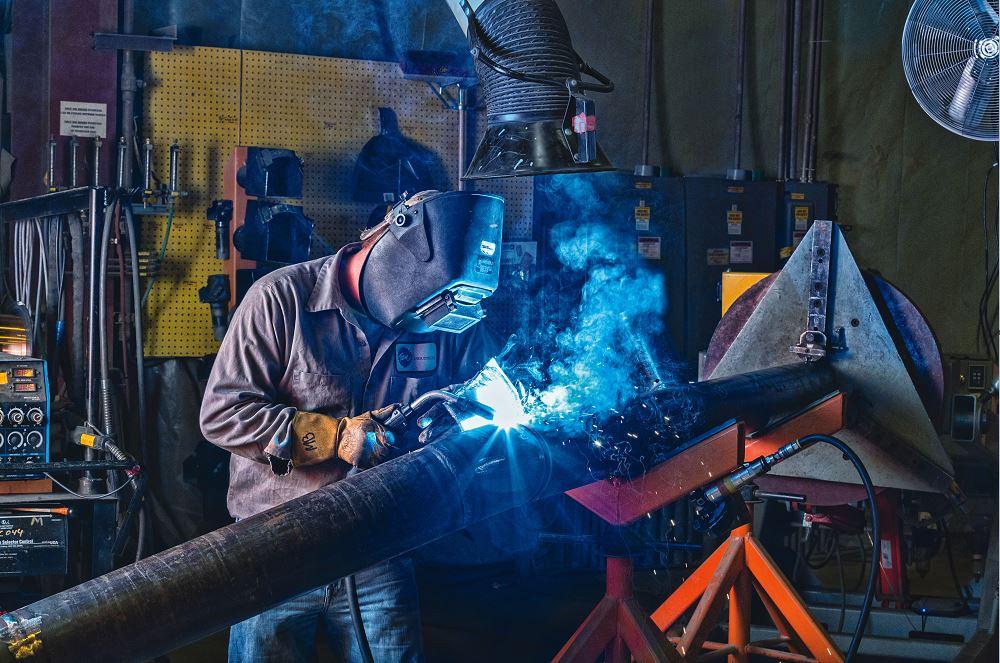Senior Editor
- FMA
- The Fabricator
- FABTECH
- Canadian Metalworking
Categories
- Additive Manufacturing
- Aluminum Welding
- Arc Welding
- Assembly and Joining
- Automation and Robotics
- Bending and Forming
- Consumables
- Cutting and Weld Prep
- Electric Vehicles
- En Español
- Finishing
- Hydroforming
- Laser Cutting
- Laser Welding
- Machining
- Manufacturing Software
- Materials Handling
- Metals/Materials
- Oxyfuel Cutting
- Plasma Cutting
- Power Tools
- Punching and Other Holemaking
- Roll Forming
- Safety
- Sawing
- Shearing
- Shop Management
- Testing and Measuring
- Tube and Pipe Fabrication
- Tube and Pipe Production
- Waterjet Cutting
Industry Directory
Webcasts
Podcasts
FAB 40
Advertise
Subscribe
Account Login
Search
Innovative weld positioning boosts throughput at Team Industries
How good workpiece positioning makes pipe welding more productive and safer
- By Tim Heston
- September 11, 2023
- Article
- Arc Welding

A worker gas tungsten arc welds a component onto a heavy-walled pipe (with a heavy end flange) on a positioner. That rotating positioner allowed the company to weld the circumferential joints in 1G and take advantage of submerged arc welding’s higher deposition rates. Images: Team Industries
The weld shops at Team Industries, a 350-employee pipe and vessel fabricator in Kaukauna, Wis., and Port Arthur, Texas, stays organized and clean, with no blue haze to speak of despite the near constant buzzing of welding arcs. Each cell has local fume extraction, and a surprising number of welders are working in 1G, even on work that isn’t typically mounted on a rotating positioner.
All welders work with wireless pedals to control a rotating chuck that, depending on the workpiece, could be more than 60 ft. away. A few are welding in 5G, with the pipe horizontal but not rotating. On some days, you might see someone welding in 6G (the pipe inclined at 45 degrees) or some other odd position, but that’s a rarity. One process, though, is conspicuously absent: postweld grinding.
“For the most part, we don’t grind [to remove excess weld metal]. If you need to grind down a weld, often it looks worse. We try to weld it properly in the first place.”
That was Tim Monday. The vice president of technical operations—and 30-year company veteran—described Team’s reputation for quality, about how in 2012 a group of welders at the company’s Port Arthur plant completed thousands of welds and 847 radiographic examinations—and didn’t produce a single defect.
Monday described several key ingredients that make such high levels of quality a reality. First, of course, is a healthy, safe work environment. The shop’s well-lit; workstations are organized; tools are easy to find. And again, the air is clear.
That sets the foundation. On top of this are two attributes that form the basis of quality welding. First is training, starting with a five-year apprenticeship program through the United Association (UA) local in Wisconsin. Second, the shop works to make a pipe welder’s life easier through innovative weld positioning. Even the most skilled welder can usually work better and faster in 1G.
Practice, Practice, Practice
The company’s roots go back to a mechanical contractor that ended up filing Chapter 11 bankruptcy in 1985. At that point, a group of employees decided they wanted to buy the assets.
“The group comprised about 20 employees,” Monday said, “and one of those people was our current president, John Panetti. They applied for small business loans, and many mortgaged their houses to try to buy off the assets. That’s where the name Team came from.” Panetti gradually bought out the other equity holders and has fully owned the company for more than 15 years.
Since that team of 20 launched Team in 1987, the company has focused solely on shop work, not field work, and by 2000 it started partnering with UA Local 400 to develop a five-year curriculum fabricator training program.
“It remains the only fabricator program [at the UA] in the United States,” Monday said.

Some pieces at Team just can’t be rotated and welded in 1G—hence the reason all welders are trained and tested to work in all positions, including 6G. Regardless, the setup is designed with safety and ergonomics in mind, with adjustable workpiece supports and local fume collection.
The company was beginning to gain a reputation for its quality welding, especially in oil and gas, yet many of its customers weren’t local; Wisconsin just isn’t a hotbed for chemical plants and refineries. Many welders in Wisconsin who focused on construction and field work simply didn’t have experience welding pressurized pipe and other components unique to the oil and gas industry. Team needed to develop talent from scratch, introducing welders to codes from the American Welding Society (AWS) and the American Society of Mechanical Engineers (ASME).
“We set up a curriculum that really taught welders about ASME B31.3, pressure piping for chemical plants and refineries, and also power plants, as covered by ASME B31.1 codes,” Monday said.
The training also focused on gas metal arc welding (GMAW, or MIG) and other wire processes performed in the shop, as well as submerged arc welding (SAW, or subarc). Training also focused on gas tungsten arc welding (GTAW, or TIG), but shielded metal arc welding (SMAW, or stick), which dominates field work, remained glaringly absent from the training program.
“That fabricator program has not only helped Team but also the other companies that hire from the UA Local 400,” Monday said. “The biggest thing is that this program really focuses on welding. It’s about practice, practice, practice.”
Part of the training involves performing a gamut of welding procedure specifications (WPS), so they’re qualified to weld specific jobs—and, of course, they need to pass X-ray tests. The training reveals shortcomings, and up-and-coming welders address those with more and more practice.
For instance, many welders with field experience can pass tests with flying colors—if, that is, they’re welding with stick or TIG. Introduce wire processes like GMAW or flux-cored arc welding, and field welding veterans sometimes run into trouble.
On their own time, Team’s welders go into the union hall to practice. “So, when they’re getting their journeyman card and they need to pass a welding test, they’re practicing,” Monday said, “then practicing some more. I’ve had many people who came from different companies tell me they thought they were good welders. Then they came to Team and experienced an entirely different level.”
X-ray (or another volumetric examination) is part of qualifying a weld, but so is a weld’s appearance. “We’re selling a product just like anyone else,” Monday said, “and visual appeal is as important as anything. And if you have a not-so-appealing weld that gets painted, it magnifies everything.”
This applies to Team’s avoidance of postweld grinding. “Let’s face it,” Monday said, “if you grind on a weld, it tends to look worse than it did before you ground it, unless it’s a really bad looking weld. So, for the most part, we just don’t grind.”
He added that welder skill is one key ingredient, all centered around the most efficient process to get the job done, usually wire feed or subarc. To get the most out of these processes and welder talent, the work needs to be presented in a certain way. This is where Team’s focus on 1G comes into play.
Rotate Whenever Possible
Every pipe welder at Team must qualify to work in 6G, one of the most challenging positions. “But let’s be honest here,” Monday said. “The way to really be productive is to weld in 1G. That comes down to positioners, and we try to roll everything we can.”
Good positioning isn’t just about productivity; it’s also about quality. No matter how good pipe welders are, if they’re wire welding a rotating pipe in 1G, they have a better chance at laying down a perfect bead than if they were making their way around a nonrotating pipe.
For about a decade, starting in the early 2000s, Team’s welders found that some attributes of off-the-shelf positioners just didn’t suit their needs, so they gradually began developing their own. They realized just how important good positioning can be, especially as welders adjust their travel to account for fit-up variabilities and other job requirements.
A positioner’s speed can be infinitely variable. As welders see a gap in the fit-up widen a tad, they can slow the rotation; when they see it narrowing, they accelerate the rotation. And, of course, they can adjust the rotation speed depending on their experience and preference. Such control helps more welders achieve better welds and pass more volumetric inspections.
Still, positioners for pipe welding had their drawbacks, especially when it came to their height. In the early 2000s, the shop employed solely fixed-height positioners. Many pipe spools have offsets, and some just couldn’t be rotated on a positioner—unless that height could be adjusted. Welders aren’t all the same height either, of course, so worker ergonomics weren’t ideal.
“A happy welder is a productive welder,” Monday said. “If you can improve the ergonomics for the welder, he’ll be happier, more productive, and weld a better weld.”
The adjustable-height positioners available on the market at the time were typically designed for structural welding, with gears driving the chuck up and down. The approach worked for the structural arena, but it wasn’t ideal for pipe welding.
So, Team developed its own positioner based on a simple, hydraulically driven scissor-lift design. This provided welders the ability to adjust the height of the chuck using a control pendant.
Early adjustable-height positioners were given to welders who worked on pipes with offsets, but not long after, just about every welder in the shop wanted one. No matter what kind of job they were welding, setting work to their preferred height made a world of difference. “Everyone could keep their back straight during welding,” Monday said. “That helped reduce welder fatigue.”
Positioner development eventually became central to Team’s continuous improvement efforts. Welders on the floor would request a certain attribute, and Team’s developers would oblige. One such improvement involved a wireless foot-pedal control, which allowed welders to rotate exceptionally long pipe sections.
Even on standard-sized work, though, welders needed to move various components in and around their work cell, and having a wire from a foot pedal in the way could be a major annoyance. Walk the floor today, and you’ll see welders using a wireless foot pedal to change the rotation speed of long pipe sections chucked into a positioner that could be 40 ft. away.
Purge requirements can be another roadblock to 1G. Team welders often work on high-alloy pipe that requires an argon purge to prevent oxidation at the weld root. Existing purge systems worked, but they added complications when trying to weld in 1G—picture hoses from the purge system wrapping around the pipe as it rotates.
“We ended up putting a purge system in the three-jaw gripper,” Monday said. “So, welders just need to plug in the purge plug from the ID of their pipe right into the plug-in in the center of the gripper. This allows a purge to keep working with a rotating pipe, without winding up a purge hose.”
The cam-style chuck is self-centering. Each jaw does not work independently. All three work together, “which is very important when you’re turning pipe,” Monday said. “You need to be at the center axis of rotation.”
This approach often helps correct pipes with ovality issues. “If you tighten the chuck, you make it round, because you’re working symmetrically,” Monday said, “at least for thin-wall pipe. Some heavy-walled pipe doesn’t give, and that does end up being slightly off center. In these cases, the roller carts we use to support the pipe away from the positioner do have some give to them, when there’s a bit of an oscillation. The welder also can monitor the oscillation and reposition if necessary. But in the vast majority of work, [a little oscillation] is entirely workable.”
Early versions of those jaws had smooth surfaces, which presented some issues for welders working on heavy-walled, large-diameter pipe. Sometimes welders had to tack the pipe to the jaws, to ensure the work remained stable throughout all weld passes. “It wasn’t the best idea,” Monday said, “but it was the safest idea.”
To address that issue, Team developed hardened jaws with serrations. “They make the entire process much safer, which is the most important thing,” Monday said.
He added that the benefits of rotating such heavy-duty work come in the resulting weld quality and the increased deposition rates. In fact, you’ll find some large, subarc-welded workpieces that wouldn’t be welded that way without Team’s positioning technology.
Team’s True Secret Sauce
Picture a 20-ft.-long pipe section with a 90-degree elbow connecting another 8 ft. of pipe. Surely, such pipe couldn’t be welded in 1G—right? Positioners, supports, and the welder could work on a platform, to allow clearance for that elbow to rotate. But what about the torque requirements? Imagine trying to rotate a smaller version of that pipe manually. As the elbow moves upward and around that 12 o’clock position, you quickly realize gravity works.
For this, Team added two hydraulic motors to increase torque, which makes the turning of these massively offset loads possible.

Welded pipe spools are staged for the next process. Even pieces with elbows and offsets are welded on a rotating positioner when practical.
“It also makes it safer,” Monday said. “If there’s any loose play in the system at all, once [the elbow] gets past top dead center, you can have a shock to the gear system. So, we put two pinion gears to not only take on more load but also lessen the amount of loose play in the system.”
That system represents the latest iteration of Team’s weld positioning technology, which the company started selling to other fabricators in 1999, when a mechanical contractor on the East Coast inquired about buying one.
Since then, the company’s positioners have made up a growing portion of its overall revenue and, for that matter, has helped accelerate product development even further. For instance, Team itself doesn’t weld large amounts of structural work that requires independently controlled jaws, but a few of its positioner customers do. So today, the company now offers a four-jaw chuck in which pairs of opposing jaws moves simultaneously and concentrically, yet each jaw pair moves independently.
Team’s success has become a case study of growth based both on technology and worker skill. In fact, Team’s welders (the fabricator employs more than 175) remain its key differentiator, which means it makes business sense to sell its positioners to other companies. In fact, the majority of the fabricator’s competitors use its positioners and grippers. In one sense, the fabricator’s positioners business sets in motion a virtuous cycle of improvement. As Team’s positioners and grippers get better, so does the company’s welding operation. Ultimately, positioners don’t represent Team’s secret sauce; they just help make its true secret sauce—its talented welders—happier and more productive.
About the Author

Tim Heston
2135 Point Blvd
Elgin, IL 60123
815-381-1314
Tim Heston, The Fabricator's senior editor, has covered the metal fabrication industry since 1998, starting his career at the American Welding Society's Welding Journal. Since then he has covered the full range of metal fabrication processes, from stamping, bending, and cutting to grinding and polishing. He joined The Fabricator's staff in October 2007.
Related Companies
subscribe now

The Fabricator is North America's leading magazine for the metal forming and fabricating industry. The magazine delivers the news, technical articles, and case histories that enable fabricators to do their jobs more efficiently. The Fabricator has served the industry since 1970.
start your free subscription- Stay connected from anywhere

Easily access valuable industry resources now with full access to the digital edition of The Fabricator.

Easily access valuable industry resources now with full access to the digital edition of The Welder.

Easily access valuable industry resources now with full access to the digital edition of The Tube and Pipe Journal.
- Podcasting
- Podcast:
- The Fabricator Podcast
- Published:
- 04/16/2024
- Running Time:
- 63:29
In this episode of The Fabricator Podcast, Caleb Chamberlain, co-founder and CEO of OSH Cut, discusses his company’s...
- Trending Articles
Tips for creating sheet metal tubes with perforations

JM Steel triples capacity for solar energy projects at Pennsylvania facility

Are two heads better than one in fiber laser cutting?

Supporting the metal fabricating industry through FMA

Omco Solar opens second Alabama manufacturing facility

- Industry Events
16th Annual Safety Conference
- April 30 - May 1, 2024
- Elgin,
Pipe and Tube Conference
- May 21 - 22, 2024
- Omaha, NE
World-Class Roll Forming Workshop
- June 5 - 6, 2024
- Louisville, KY
Advanced Laser Application Workshop
- June 25 - 27, 2024
- Novi, MI




























